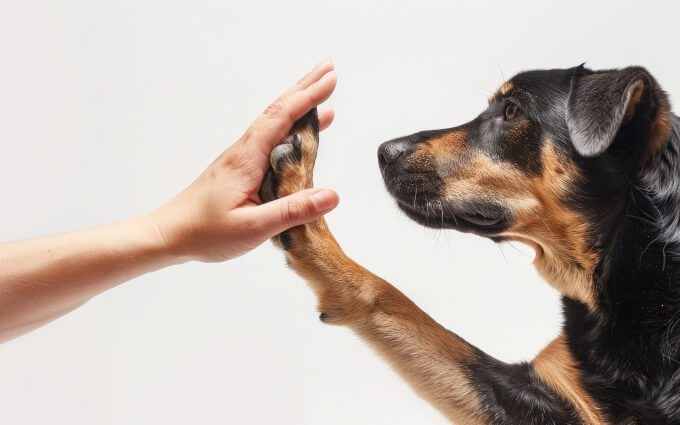- Home
- Dog Behavior
- How Long Should You Walk Your Dog? The Optimal Length for Your Daily Strolls
How Long Should You Walk Your Dog? The Optimal Length for Your Daily Strolls
Walking your dog is essential for their physical and mental health. Find out how long you should walk your dog, considering their age, breed, and health, to ensure they get the best out of their daily strolls.

- 39

The Importance of Walking Your Dog
Walking your dog isn't just about exercise; it's a key component of their overall health and well-being. Regular walks provide your furry friend with physical activity, mental stimulation, and opportunities for socialization. Plus, it's a great way for you to stay active and bond with your pet.
Health Benefits
- Physical Health:Regular walks help maintain a healthy weight, improve cardiovascular health, and strengthen muscles and joints.
- Mental Health:Walks provide new sights, sounds, and smells, which keep your dog mentally sharp and reduce anxiety and boredom.
- Behavioral Benefits:Regular exercise can reduce problem behaviors like excessive barking, chewing, and hyperactivity.
Factors Influencing Walk Duration
The optimal length of a walk varies greatly depending on your dog's age, breed, health, and energy level. Here's how these factors play a role:
Age
Puppies:Puppies have boundless energy but limited stamina. Short, frequent walks (5-10 minutes, three times a day) are ideal, helping with potty training and leash training.
Adults:Healthy adult dogs benefit from longer walks. Aim for 30-60 minutes twice a day, depending on your dog's energy levels and fitness.
Seniors:Older dogs might not need as much exercise. Gentle, shorter walks (20-30 minutes) once or twice a day help maintain their health without overexertion.
Breed and Size Considerations
Different breeds have different exercise needs. Here's a quick guide:
Small Breeds
- Small dogs like Chihuahuas and Pomeranians need less exercise. Short walks (15-30 minutes) twice a day are sufficient.
Medium to Large Breeds
- Breeds such as Beagles and Retrievers enjoy and need longer walks (30-60 minutes, twice a day) to stay healthy and happy.
Athletic Breeds
- High-energy breeds like Border Collies and Huskies require extensive exercise. They thrive on long walks (60 minutes or more, twice a day) and additional activities like running or hiking.
Flat-Faced Breeds
- Breeds with short snouts, such as Bulldogs and Pugs, may struggle with breathing during exercise. Opt for shorter, more frequent walks (15-30 minutes) and avoid strenuous activity.
Health and Special Considerations
Always tailor walks to your dog's health and individual needs. Here are some tips:
Health Conditions
- If your dog has arthritis or heart issues, shorter, gentle walks are best. Consult your vet for specific advice.
Weather Conditions
- Avoid extreme weather. Walk in the early morning or late evening during hot months and keep walks short during cold weather.
Behavioral Needs
- High-energy dogs need more exercise to prevent destructive behaviors. Incorporate playtime and mental exercises to keep them stimulated.
Creating the Perfect Walking Routine
Establishing a consistent walking routine is crucial for your dog's well-being. Here's how to create an effective schedule:
Frequency and Timing
- Aim for at least one longer walk and multiple shorter potty breaks each day. Consistency helps your dog know what to expect and reduces anxiety.
Flexibility
- Adjust the routine based on your dog's needs and your schedule. Weekends might allow for longer walks or additional playtime.
Engagement
- Make walks interesting by changing routes, incorporating training exercises, and allowing sniffing breaks.
Frequently Asked Questions about Walking Your Dog
How long should I walk my dog each day?
Most dogs need at least 30 minutes to 2 hours of exercise daily, depending on age, breed, and health.
Do different dog breeds need different walk lengths?
Yes, active breeds like Border Collies or Huskies need longer walks, while smaller or less active breeds require shorter ones.
Is one long walk or multiple short walks better?
Multiple shorter walks are often better for most dogs, as they provide regular stimulation and bathroom breaks.
Can I walk my puppy the same as an adult dog?
No, puppies need shorter, gentler walks to avoid stress on their developing joints.
What happens if my dog doesn't get enough walks?
Without enough exercise, dogs may develop behavioral problems, weight issues, or excess energy.
- 39
 Michelle Torring
Michelle Torring
Michelle is a passionate dog owner who spends most of her free time with her 6-year-old golden retriever, Bella. The two are a familiar sight in the neighborhood, often seen on long walks in the park or at the beach. Michelle loves training Bella in agility and they often compete in local competitions where Bella impresses with her speed and agility. Every Sunday, Michelle organizes playdates for dogs in the neighborhood where both dogs and owners can socialize and learn from each other. To Michelle, Bella is not just a dog, but a beloved family member and faithful companion.
-
Food & Nutrition
 The Best Foods to Boost Your Dog's Immune System
The Best Foods to Boost Your Dog's Immune SystemTo keep your dog healthy and resilient, fueling their immune system with the right foods is key. In this post, we'll cover the top nutrient-packed foods that can give your dog's immune system the support it needs, helping them fend off illness and stay energetic.
 Marcin SolgaardOct 04, 20249
Marcin SolgaardOct 04, 20249 -
Dog Behavior
 Does My Dog Know I Care About It?
Does My Dog Know I Care About It?Discover the ways your dog shows it knows you care and how you can reinforce that loving bond through simple actions and daily interactions.
 Cassandra DalgaardAug 05, 202444
Cassandra DalgaardAug 05, 202444 -
Dog health
 Essential Tips for Caring for Your Dog's Teeth and Gums
Essential Tips for Caring for Your Dog's Teeth and GumsMaintaining your dog's dental health is crucial for their overall well-being. This guide covers various methods to care for your dog's teeth and gums, ensuring they stay healthy and happy.
 Cassandra DalgaardAug 19, 202436
Cassandra DalgaardAug 19, 202436 -
Dog health
 Which Emotions Do Dogs Actually Experience? Understanding Your Dog's Emotions
Which Emotions Do Dogs Actually Experience? Understanding Your Dog's EmotionsDogs experience a variety of basic emotions similar to those of a young child. Learn about the emotions your dog truly feels, how they express them, and what it means for your relationship.
 Cassandra DalgaardJul 30, 202478
Cassandra DalgaardJul 30, 202478 -
Puppies & Young dogs
 How to Puppy-Proof Your Home: A Complete Guide
How to Puppy-Proof Your Home: A Complete GuideBringing a new puppy home is thrilling, but keeping them safe means some serious puppy-proofing. This guide covers everything from securing hazardous items to creating a puppy-friendly zone, making your home a safe haven for your curious new companion.
 Michelle TorringOct 10, 202412
Michelle TorringOct 10, 202412 -
Puppies & Young dogs
 New Puppy? Here's What You Need to Buy
New Puppy? Here's What You Need to BuyPreparing for a new puppy involves gathering essential supplies to ensure they have a comfortable and happy start in their new home. Here's your ultimate shopping list!
 Marcin SolgaardMay 06, 202448
Marcin SolgaardMay 06, 202448 -
Tips & Tricks
 How to Train Your Dog to Give Paw
How to Train Your Dog to Give PawTeaching your dog to give paw is a fun and rewarding experience that strengthens your bond. This guide walks you through the process with tips, tricks, and plenty of paw-sitive reinforcement.
 Marcin SolgaardApr 11, 202441
Marcin SolgaardApr 11, 202441 -
Tips & Tricks
 How to Train Your Dog to Walk Off-Leash
How to Train Your Dog to Walk Off-LeashThis guide will walk you through everything you need to know, from essential commands to mastering off-leash walks even in distracting environments
 Marcin SolgaardJul 02, 202451
Marcin SolgaardJul 02, 202451 -
Food & Nutrition
 Dog Supplements: When and Why to Use Them
Dog Supplements: When and Why to Use ThemDog supplements can enhance your furry friend's health by filling nutritional gaps and addressing specific health issues. Learn when and why to use them.
 Michelle TorringAug 28, 202432
Michelle TorringAug 28, 202432 -
Food & Nutrition
 How to Choose the Right Diet for Your Allergic Dog
How to Choose the Right Diet for Your Allergic DogFind out how to select the perfect diet for your dog with allergies. Learn about elimination diets, hypoallergenic foods, and the best ingredients to keep your furry friend healthy and happy.
 Marcin SolgaardJun 09, 202427
Marcin SolgaardJun 09, 202427










